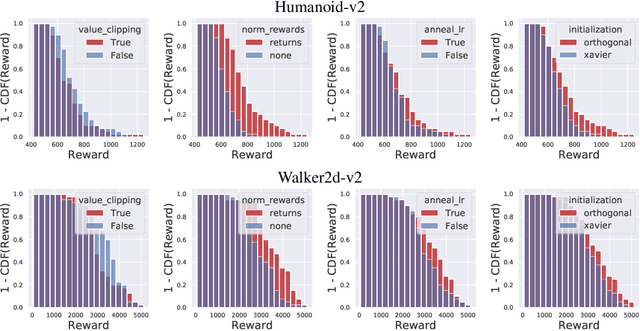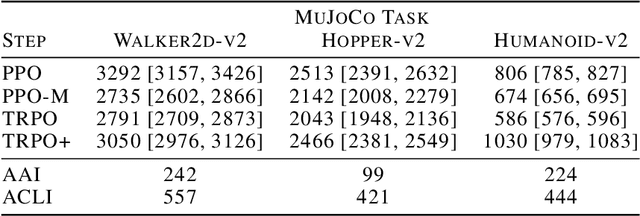Firdaus Janoos
Implementation Matters in Deep Policy Gradients: A Case Study on PPO and TRPO
May 25, 2020



Abstract:We study the roots of algorithmic progress in deep policy gradient algorithms through a case study on two popular algorithms: Proximal Policy Optimization (PPO) and Trust Region Policy Optimization (TRPO). Specifically, we investigate the consequences of "code-level optimizations:" algorithm augmentations found only in implementations or described as auxiliary details to the core algorithm. Seemingly of secondary importance, such optimizations turn out to have a major impact on agent behavior. Our results show that they (a) are responsible for most of PPO's gain in cumulative reward over TRPO, and (b) fundamentally change how RL methods function. These insights show the difficulty and importance of attributing performance gains in deep reinforcement learning. Code for reproducing our results is available at https://github.com/MadryLab/implementation-matters .
Are Deep Policy Gradient Algorithms Truly Policy Gradient Algorithms?
Dec 02, 2018



Abstract:We study how the behavior of deep policy gradient algorithms reflects the conceptual framework motivating their development. We propose a fine-grained analysis of state-of-the-art methods based on key aspects of this framework: gradient estimation, value prediction, optimization landscapes, and trust region enforcement. We find that from this perspective, the behavior of deep policy gradient algorithms often deviates from what their motivating framework would predict. Our analysis suggests first steps towards solidifying the foundations of these algorithms, and in particular indicates that we may need to move beyond the current benchmark-centric evaluation methodology.
Active Mean Fields for Probabilistic Image Segmentation: Connections with Chan-Vese and Rudin-Osher-Fatemi Models
Oct 04, 2016



Abstract:Segmentation is a fundamental task for extracting semantically meaningful regions from an image. The goal of segmentation algorithms is to accurately assign object labels to each image location. However, image-noise, shortcomings of algorithms, and image ambiguities cause uncertainty in label assignment. Estimating the uncertainty in label assignment is important in multiple application domains, such as segmenting tumors from medical images for radiation treatment planning. One way to estimate these uncertainties is through the computation of posteriors of Bayesian models, which is computationally prohibitive for many practical applications. On the other hand, most computationally efficient methods fail to estimate label uncertainty. We therefore propose in this paper the Active Mean Fields (AMF) approach, a technique based on Bayesian modeling that uses a mean-field approximation to efficiently compute a segmentation and its corresponding uncertainty. Based on a variational formulation, the resulting convex model combines any label-likelihood measure with a prior on the length of the segmentation boundary. A specific implementation of that model is the Chan-Vese segmentation model (CV), in which the binary segmentation task is defined by a Gaussian likelihood and a prior regularizing the length of the segmentation boundary. Furthermore, the Euler-Lagrange equations derived from the AMF model are equivalent to those of the popular Rudin-Osher-Fatemi (ROF) model for image denoising. Solutions to the AMF model can thus be implemented by directly utilizing highly-efficient ROF solvers on log-likelihood ratio fields. We qualitatively assess the approach on synthetic data as well as on real natural and medical images. For a quantitative evaluation, we apply our approach to the icgbench dataset.
 Add to Chrome
Add to Chrome Add to Firefox
Add to Firefox Add to Edge
Add to Edge